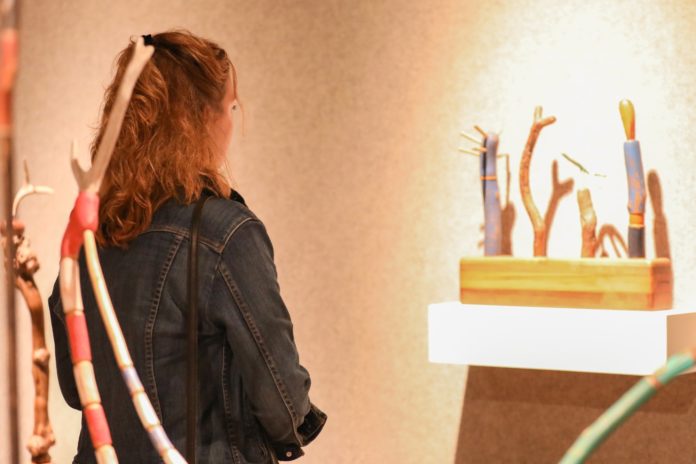
By Cassidy Pate | Reporter
A crowd of people gathered at the Martin Museum of Art to observe opening night of it’s newest exhibition, Danville Chadbourne: Retrospective Part IV: Small Wooden Sculptures, which was followed by an artist talk and reception in the museum on Thursday night. This exhibition of wooden sculptures will be displayed from Oct. 5 to Nov.12.
Texas-based artist and sculptor Chadbourne is well known for his clay, woodwork and interpretation of art. He spoke about his fourth exhibition, “Small Wooden Sculptures,” which has been in the works since the early 1980s.
“I work in lots of different materials, as I said: Clay and wood are the dominant ones,” Chadbourne said. “I work in two dimensional formats and three dimensional formats — from very small scale to very large pieces — and I’ve always done that. It’s just part of my bizarre way of working it.”
Dr. Megan Biesele, anthropologist and friend of Chadbourne’s, introduced Chadbourne and spoke about his love affair with wood.
“I think that this exhibition does a great job of exploring the welter [collection] of production of this very, very productive artist,” Biesele said.
From Chadbourne’s rural childhood grew a respect for nature, which explains his use of natural and organic processes when creating his masterpieces. He said the majority of his materials come from his own backyard.
Chadbourne’s work often embodies the characteristics of ancient tools with beaded fiber and other adornments, but he tries to start with new materials that he can then age to perfection.
“I want the notion of time to be built into the work from the very beginning so that it has this sort of sense of existing, having existed [and] having some experience existing in this continuity that we call time,” Chadbourne said.
An advocate for the viewer developing their own understanding of art, Chadbourne said all of the works in the exhibition were created with suggested possibilities or narratives.
“Art should be about some deeper, more complex experience that has involves you at some bigger level than just presenting the most superficial part,” Chadbourne said.
The titles of his works enhance these deeper meanings. One piece, titled “The Irresistible Renewal of Contradiction,” has a green and white checkered base with orange, purple and lime green embellishments that can refer the viewer back to the title while giving them the opportunity to find their own meaning in the work. As a result of his past desire to become a writer, Chadbourne said the titles come from his interpretation of the art in a poetic language that makes it harder for the viewer to comprehend.
“[The titles are] not whimsical, and they’re not frivolous,” Chadbourne said. “They’re very serious and they’re very deliberate.”
Chadbourne continued to answer questions about his work and his intentions with art. One person in attendance asked how his process evolves over time.
In response, Chadbourne said that he sees himself as an accumulator, he is constantly collecting things and simultaneously working on various pieces at one time. Once he has focused in on one piece, he moves into the formal decision process and determines how each work is presented from the base and its orientation to which materials and colors make sense for each project.
“It’s kind of a complex circumstance of fooling around, waiting around, looking at it sideways, not paying attention to it, but then also committing to it absolutely,” Chadbourne said.
Steve Bennett of the San Antonio Express-News wrote an article based on Chadbourne’s process in 2012.
“Obviously, he is patient, allowing works to evolve over time,” Steve Bennett said in the article. “More importantly, he thinks deeply about each work, inculcating it not only with his own personal story, but with his lifelong studies of history, anthropology, science, mathematics.”
To witness this exhibition, museum hours of operation can be found here.





